Unveiling the Allianz Arena, a captivating architectural marvel and a renowned sporting sanctuary, this comprehensive guide immerses you in the stadium’s captivating history, innovative design, and profound impact on Munich’s sporting and cultural landscape.
Nestled amidst the vibrant cityscape of Munich, the Allianz Arena stands as a testament to architectural ingenuity and sustainable practices, showcasing a mesmerizing facade that transforms into a breathtaking spectacle of light and color during matches.
Overview of Allianz Arena
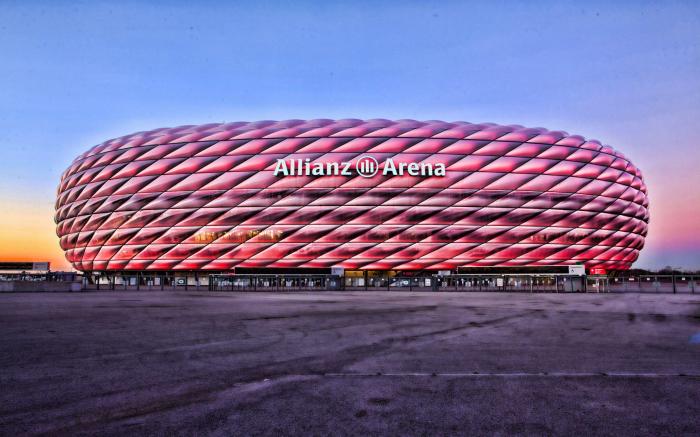
The Allianz Arena, located in Munich, Germany, is a state-of-the-art football stadium that serves as the home ground for Bayern Munich. With a seating capacity of over 75,000, it is one of the largest and most technologically advanced stadiums in the world.
The Allianz Arena, a magnificent architectural marvel, stands as a testament to sporting excellence. However, if you’re seeking a respite from the adrenaline-fueled atmosphere, consider indulging in the tranquility of luxury beach resorts. Whether you desire sun-kissed sands or azure waters, these exclusive havens offer an idyllic escape from the bustling metropolis.
But don’t forget to return to the Allianz Arena, where the roar of the crowd awaits, reminding you of the passion and spectacle that makes this stadium so iconic.
The stadium’s striking architectural design, conceived by Swiss architects Herzog & de Meuron, is a prominent feature. Its exterior is composed of 2,874 diamond-shaped ETFE (ethylene tetrafluoroethylene) panels that illuminate in different colors, transforming the stadium into a vibrant spectacle during matches.
Sustainable Construction
Sustainability was a key consideration in the design of the Allianz Arena. The ETFE panels, apart from their aesthetic appeal, also serve as a highly effective insulating material, reducing energy consumption for heating and cooling. The stadium also features rainwater harvesting systems, solar panels, and a geothermal heating system, making it one of the most environmentally friendly stadiums in the world.
History and Evolution of Allianz Arena
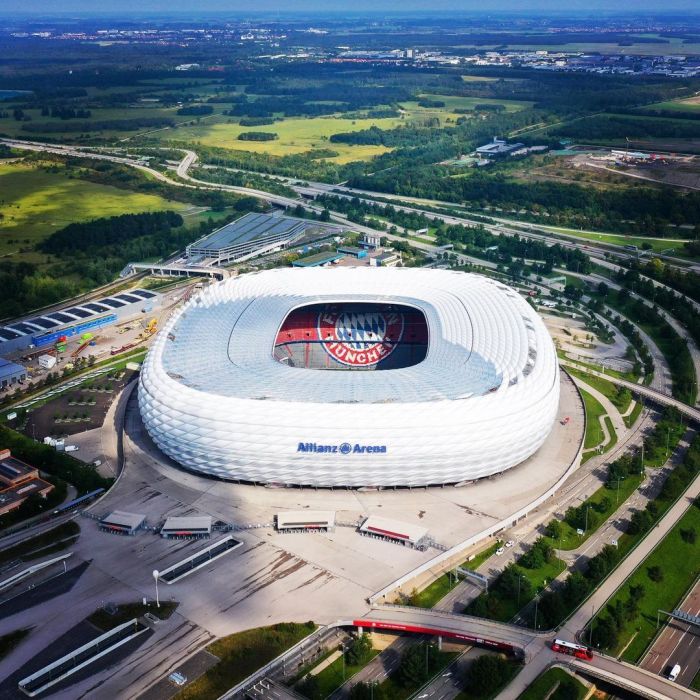
The Allianz Arena, renowned for its architectural marvel and vibrant atmosphere, has undergone a remarkable journey since its inception. Its history is intertwined with key milestones and transformative events that have shaped its present-day status as a world-class sports and entertainment venue.
The stadium’s genesis can be traced back to the early 2000s when FC Bayern Munich and TSV 1860 Munich embarked on a joint venture to construct a state-of-the-art stadium. The groundbreaking ceremony took place in 2002, and the stadium was officially inaugurated in 2005.
Key Milestones
- 2002: Groundbreaking ceremony marks the commencement of construction.
- 2005: Official inauguration of the Allianz Arena, hosting its first match between FC Bayern Munich and Borussia Mönchengladbach.
- 2006: The stadium becomes a centerpiece of the FIFA World Cup, hosting several matches, including the semifinals and the third-place match.
- 2012: The Allianz Arena undergoes a major renovation, including the installation of a new roof and facade lighting system.
- 2017: The stadium hosts the UEFA Champions League final, showcasing its capabilities as a world-class event venue.
Throughout its evolution, the Allianz Arena has remained at the forefront of stadium design and innovation. Its iconic exterior, featuring a translucent ETFE (ethylene tetrafluoroethylene) facade, allows for dynamic lighting displays that transform the stadium’s appearance during matches and events.
The Allianz Arena has become an integral part of the Munich cityscape and a symbol of German footballing excellence. Its rich history and ongoing evolution continue to make it one of the most recognizable and admired stadiums in the world.
Architectural Significance of Allianz Arena

The Allianz Arena, with its iconic exterior, is an architectural marvel that has redefined stadium design. Its innovative use of materials and groundbreaking design have made it a global landmark and a symbol of modern sports architecture.
The stadium’s facade, composed of 2,874 diamond-shaped panels, is a technological masterpiece. Each panel is made of ETFE (ethylene tetrafluoroethylene), a lightweight and translucent material that allows for vibrant color displays. The panels can be illuminated in various colors, creating a mesmerizing spectacle that transforms the stadium into a beacon of light at night.
Impact on Urban Environment
The Allianz Arena has had a transformative impact on its surrounding urban environment. Its striking design and strategic location have made it a focal point for the city of Munich. The stadium complex includes a vibrant retail and entertainment district, creating a lively atmosphere on match days and beyond.
Comparison to Other Stadiums
Compared to other notable sports stadiums worldwide, the Allianz Arena stands out for its innovative architectural features. Its dynamic facade, advanced lighting system, and sustainable design elements set it apart from traditional stadiums. The stadium’s unique design has earned it numerous awards and accolades, solidifying its place as a global architectural icon.
Sporting Events and Cultural Impact
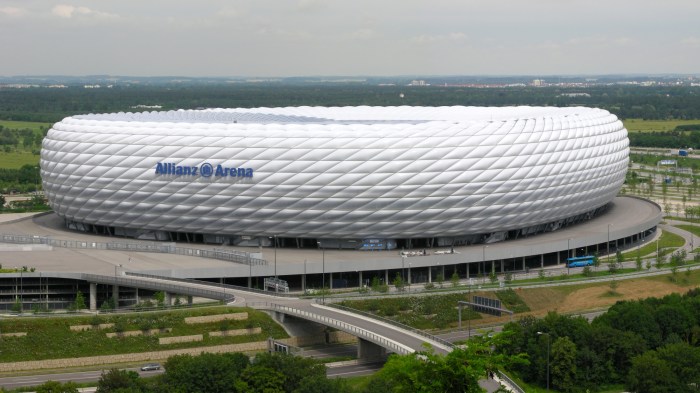
The Allianz Arena has been a prominent venue for major sporting events, including the FIFA World Cup in 2006 and numerous UEFA Champions League matches. The stadium’s state-of-the-art facilities and massive capacity have made it an ideal destination for these prestigious events, showcasing the highest level of footballing talent.
Impact on Local Community and Sports Promotion
The Allianz Arena has had a profound impact on the local community. It has revitalized the surrounding area, attracting businesses and investments to the region. The stadium’s presence has also fostered a strong sense of community pride and unity, particularly among Bayern Munich fans. The stadium’s commitment to promoting sports and physical activity has inspired countless young people to pursue their athletic dreams.
Non-Sporting Events
Beyond sporting events, the Allianz Arena has also been utilized for a wide range of non-sporting events, such as concerts, exhibitions, and corporate functions. Its flexible design and versatile spaces allow for various events to be accommodated, making it a sought-after venue for entertainment and cultural activities. The stadium’s modern architecture and stunning visuals have made it a popular backdrop for music performances and art installations.
Economic Impact of Allianz Arena
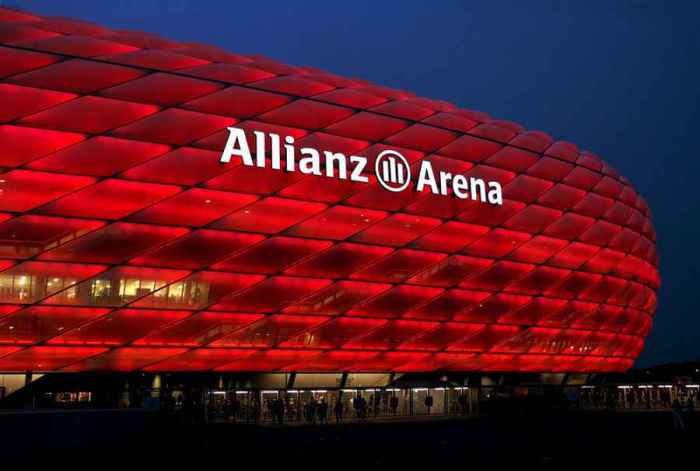
The Allianz Arena has had a significant economic impact on the city of Munich and the surrounding region. The stadium has attracted millions of visitors, generated revenue, and created employment opportunities.
One of the most significant economic impacts of the Allianz Arena has been its role in attracting tourism. The stadium has hosted numerous high-profile sporting events, including the 2006 FIFA World Cup and the 2012 UEFA Champions League Final. These events have brought millions of visitors to Munich, who have spent money on accommodation, food, and entertainment.
Tourism
- Attracted millions of visitors
- Generated revenue from accommodation, food, and entertainment
The Allianz Arena has also generated revenue for the city of Munich. The stadium is owned by FC Bayern Munich, which pays rent to the city. The city also receives revenue from taxes on ticket sales and concessions.
Revenue Generation
- Rent paid by FC Bayern Munich
- Taxes on ticket sales and concessions
In addition to generating revenue, the Allianz Arena has also created employment opportunities. The stadium employs hundreds of people, including security guards, ticket takers, and concession workers.
Employment Opportunities
- Security guards
- Ticket takers
- Concession workers
The economic impact of the Allianz Arena is expected to continue to be significant in the long term. The stadium is a major tourist attraction and a source of revenue for the city of Munich. It is also a symbol of the city’s sporting and cultural heritage.
Long-Term Economic Benefits
- Continued tourism attraction
- Stable revenue source for the city
- Symbol of Munich’s sporting and cultural heritage
Sustainability and Environmental Impact
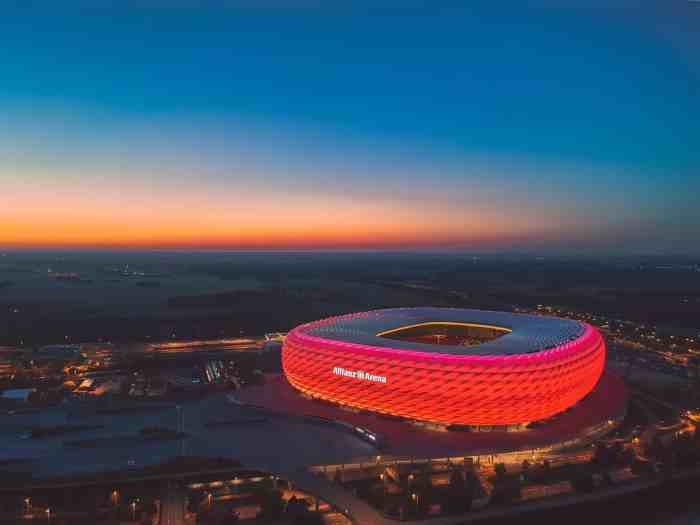
The Allianz Arena has been designed with sustainability and environmental responsibility at its core. The stadium is committed to minimizing its environmental footprint through energy efficiency, waste management, and the use of renewable resources.
The Allianz Arena is a stunning sports stadium known for its innovative design. Its translucent panels illuminate the exterior, creating a captivating display. While in Munich, art enthusiasts may also want to visit the renowned Accademia Gallery in Florence, which houses masterpieces by Michelangelo and other Renaissance greats.
Upon returning to the Allianz Arena, one can appreciate the stadium’s architectural brilliance and the vibrant atmosphere during match days.
The stadium’s innovative exterior facade, made up of ETFE panels, allows for natural light to flood the interior, reducing the need for artificial lighting. The panels also act as a thermal insulation, helping to regulate the temperature inside the stadium and reducing energy consumption.
Energy Efficiency, Allianz arena
- The Allianz Arena uses LED lighting throughout the stadium, which is significantly more energy-efficient than traditional lighting systems.
- The stadium also has a rainwater harvesting system that collects rainwater from the roof and stores it in underground tanks. This water is then used for irrigation and other non-potable purposes, reducing the stadium’s reliance on municipal water supplies.
- The stadium’s heating and cooling systems are also highly efficient, using geothermal energy and heat recovery systems to minimize energy consumption.
Waste Management
- The Allianz Arena has implemented a comprehensive waste management program that includes recycling, composting, and waste reduction initiatives.
- The stadium has a dedicated waste sorting facility where all waste is separated and recycled or composted whenever possible.
- The stadium also works with local waste management companies to ensure that all waste is disposed of in an environmentally responsible manner.
Use of Renewable Resources
- The Allianz Arena uses renewable energy sources, such as solar and wind power, to supplement its energy needs.
- The stadium has a photovoltaic system installed on its roof that generates solar electricity.
- The stadium also has a wind turbine that generates electricity from the wind.
The Allianz Arena’s sustainability features have earned it recognition as one of the most environmentally friendly stadiums in the world. The stadium has received numerous awards for its sustainability efforts, including the LEED Platinum certification from the U.S. Green Building Council.
The Allianz Arena, a magnificent architectural marvel and home to Bayern Munich, stands as a testament to the city’s sporting legacy. If you’re planning your 2024 travels, be sure to explore the best travel destinations for that year. And when in Munich, don’t miss the opportunity to witness a match at the Allianz Arena, where the roar of the crowd will leave you in awe.
Future Development and Legacy
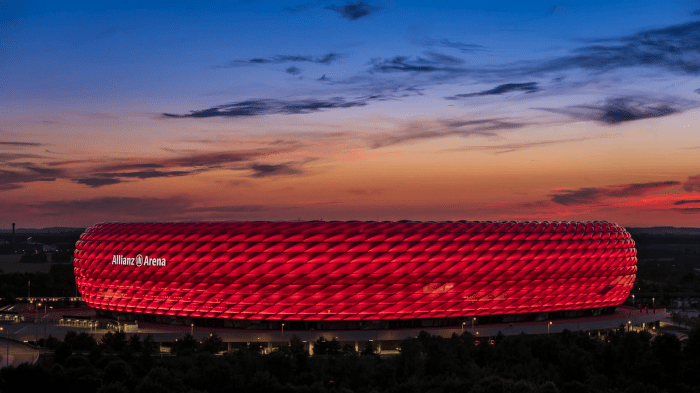
The Allianz Arena is constantly evolving to meet the changing needs of sports and entertainment. Future development plans include upgrades to the stadium’s technology, infrastructure, and fan experience. The stadium’s exterior lighting system will be enhanced to create even more spectacular light displays. The seating capacity may be expanded to accommodate larger crowds. New hospitality areas and VIP suites will be added to provide a more luxurious experience for premium ticket holders. The stadium’s concourses and concession areas will be redesigned to improve flow and reduce congestion.
Legacy
The Allianz Arena has already cemented its place as a landmark in Munich and a world-class sporting and cultural venue. The stadium has hosted numerous major events, including the 2006 FIFA World Cup and the 2012 UEFA Champions League Final. It has also been the home of FC Bayern Munich, one of the most successful football clubs in the world. The Allianz Arena’s unique design and innovative features have made it a popular tourist destination. The stadium has also had a positive economic impact on the city of Munich, generating jobs and revenue. The Allianz Arena is expected to continue to be a major landmark and a source of pride for Munich for many years to come.
Last Point
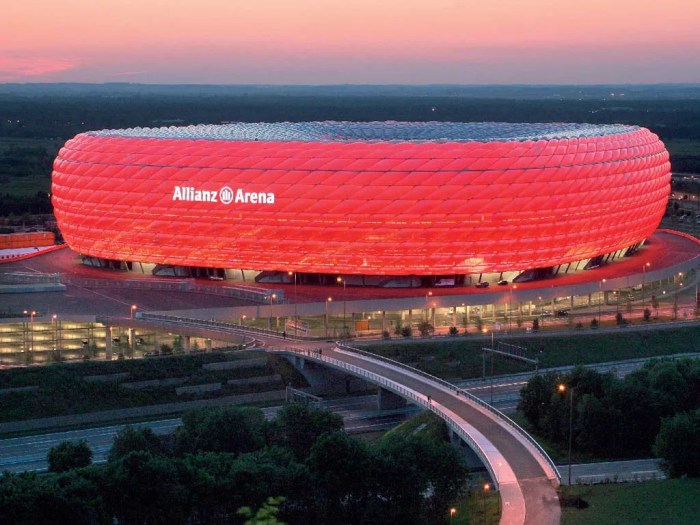
As a symbol of Munich’s sporting prowess and architectural excellence, the Allianz Arena continues to inspire and captivate. Its legacy as a world-class venue and a catalyst for community engagement ensures that it will remain a beloved landmark for generations to come.
Answers to Common Questions
What is the capacity of the Allianz Arena?
The Allianz Arena has a capacity of 75,024 spectators.
Who are the home teams that play at the Allianz Arena?
FC Bayern Munich and TSV 1860 Munich are the two home teams that play at the Allianz Arena.
What is the unique feature of the Allianz Arena’s facade?
The Allianz Arena’s facade is made up of 2,874 ETFE panels that can be illuminated in different colors, creating a stunning visual display.